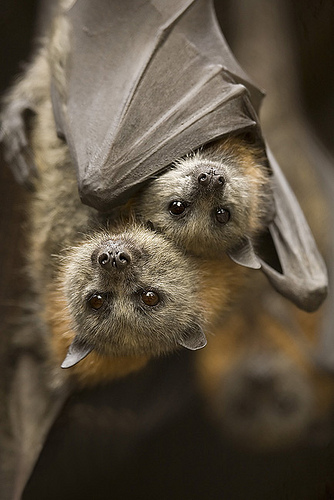A long time ag o, people used to think bats were birds without feathers. But now we know that there is no such thing as a featherless bird. We know that bats are MAMMALS, just like people.
o, people used to think bats were birds without feathers. But now we know that there is no such thing as a featherless bird. We know that bats are MAMMALS, just like people.
These things that tell us bats are mammals:
- bats are warm blooded – this means they can keep their bodies warmer than the temperature around them, just like you!
- bats nurse their babies with milk – this means a baby drinks milk from its mother’s body.
- bats have fur that cover their bodies but not their wings.
Bats are very special mammals. They are the only mammals that can fly (without an airplane!) Flying squirrels are mammals too, but they don’t really fly. They jump from high in a tree and glide through the air like a kite (or Buzz Lightyear). But bats flap their wings and fly like a bird.

Baby Bumblebee Bat
There are a lot of different kinds of bats — from the tiny bumblebee bat (which is the size of a jellybean and weighs less than a penny when born) to the huge Bismark flying fox (with a wingspan as long as an average man).
In fact, there are over 900 different species of bats — they make up one fifth of the world’s mammals. They are the second largest group of mammals (rodents are the largest). Bats live all over the world, from the United States to Australia except for in the cold areas.

Bismark Flying Fox (a bat)
Bats are grouped into two main groups — the fruit eating bats (also known as “flying fox bats” or “megabats”) and the microbats that eat insects, blood, fish, lizards, birds and nectar. (Although mega means large and micro means small, some microbats are larger than some megabats!)
Megabats and microbats are quite different from one another. Microbats live worldwide, except for Antarctica and most of the arctic region. Most of the world’s bats are microbats.
Megabats include nearly 200 species and live in tropical regions. They look a lot more like land mammals we’re familiar with — which is why they’re called “flying foxes”. Most megabats are unable to echolocate, although there are a few (like the Egyptian Rousette) that can. Megabats use the great sense of smell, and eyesight, to help them find food.
1: Introduction | 2: Wings | 3. Diet | 4. Habitat | 5. Babies | 6. Senses | 7. More About Bats
